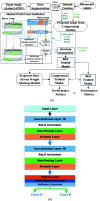Locomo-Net: A Low -Complex Deep Learning Framework for sEMG-Based Hand Movement Recognition for Prosthetic Control
- PMID: 33014638
- PMCID: PMC7529116
- DOI: 10.1109/JTEHM.2020.3023898
Locomo-Net: A Low -Complex Deep Learning Framework for sEMG-Based Hand Movement Recognition for Prosthetic Control
Abstract
Background: The enhancement in the performance of the myoelectric pattern recognition techniques based on deep learning algorithm possess computationally expensive and exhibit extensive memory behavior. Therefore, in this paper we report a deep learning framework named 'Low-Complex Movement recognition-Net' (LoCoMo-Net) built with convolution neural network (CNN) for recognition of wrist and finger flexion movements; grasping and functional movements; and force pattern from single channel surface electromyography (sEMG) recording. The network consists of a two-stage pipeline: 1) input data compression; 2) data-driven weight sharing. Methods: The proposed framework was validated on two different datasets- our own dataset (DS1) and publicly available NinaPro dataset (DS2) for 16 movements and 50 movements respectively. Further, we have prototyped the proposed LoCoMo-Net on Virtex-7 Xilinx field-programmable gate array (FPGA) platform and validated for 15 movements from DS1 to demonstrate its feasibility for real-time execution. Results: The effectiveness of the proposed LoCoMo-Net was verified by a comparative analysis against the benchmarked models using the same datasets wherein our proposed model outperformed Twin- Support Vector Machine (SVM) and existing CNN based model by an average classification accuracy of 8.5 % and 16.0 % respectively. In addition, hardware complexity analysis is done to reveal the advantages of the two-stage pipeline where approximately 27 %, 49 %, 50 %, 23 %, and 43 % savings achieved in lookup tables (LUT's), registers, memory, power consumption and computational time respectively. Conclusion: The clinical significance of such sEMG based accurate and low-complex movement recognition system can be favorable for the potential improvement in quality of life of an amputated persons.
Keywords: CNN; data compression; movement classification; sEMG; signal processing; weights compression.
Figures











References
-
- Hamzaid N. A., Mohd Yusof N. H., and Jasni F., “Sensory systems in micro-processor controlled prosthetic leg: A review,” IEEE Sensors J., vol. 20, no. 9, pp. 4544–4554, May 2020.
-
- Parker P., Englehart K., and Hudgins B., “Myoelectric signal processing for control of powered limb prostheses,” J. Electromyogr. Kinesiol., vol. 16, no. 6, pp. 541–548, Dec. 2006. - PubMed

